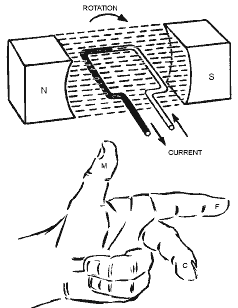 |
AC Voltage Generation
You need to notice a few key points about this voltage generation setup.
1. When the coil begins to rotate, the current flows out of the dark side of the look, and flows into the light side of the loop. As the coil rotates, it will eventually turn 180 degrees. At that time, the dark side of the loop will occupy the position currently held by the light side of the loop and vice versa. At that time the current flow through the loop will be in the opposite direction (because now the dark side of the loop is moving downward instead of upward). This is a characteristic of rotational motion. To complete rotation, any portion of the coil has to go through both the upward and the downward motion. Since we know the direction of the motion determines the direction of the current flow, therefore we realize why the current flow direction will alternate.
2. Consider the coil as it shown. As the coil moves it cuts the magnetic lines of force. Let’s see what happens when, as a part of its rotation, it has turned by 90 degrees. At this point, for a brief moment, the conductor loop will move in parallel to the magnetic lines of force. Since the parallel motion does not cut any lines of force, no voltage is produced. Therefore, at the beginning the coil will have a certain amount of voltage, but as it moves to ninety degrees the voltage drops to zero. After that as it moves beyond ninety degrees, lines of force gets cut and voltage is generated. This should explain why the sinusoidal voltage goes through zero and then becomes negative.